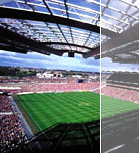Good Sports
France will have the honour of being the first foreign team to play a non-Gaelic sport in Dublin's Croke Park, when their rugby team takes on Ireland in the Six Nations' Championship in February 2007. A revolution indeed!
And so the high priests of Ireland's Gaelic sports have finally repealed the so-called Rule 42, to allow soccer and rugby to be played under certain circumstances on the sacred ground of Croke Park. For French readers, let me explain what that means. Imagine Chateau Lafitte launching a new Chateau Lite in a can. For Croke Park is not only Ireland's largest stadium and the fourth largest in Europe, it is to Gaelicdom what claret is to Frenchdom.
Since its founding a century ago, it has been an English-free zone, with no rugger and definitely no socceire. It is the cultural home of Gaelic football (a cross between soccer and rugby) and hurling (a furious sort of hockey). But as old Lansdowne Road is finally about to be renovated, no other major stadium is available, hence the softening of the ban. Apart from the decision itself, a major surprise to me is that you have to go all the way down to number 42 to find the rule. (I wonder what Rule 1 says.)
But let's not pontificate about such peculiarities. Rules are rules, and this repeal is enlightening. Rather, let me use this opportunity to pay tribute to the cathedrals of sport themselves. And let's face it, stadia are places of worship. I have been to a few, full and empty alike. Even from the outside, they stand as monuments to behold: Madrid's Bernabeu on the Paseo, Wembley's towers, the Giants' bowl lighting the night sky in New York, even the Colosseum: each stadium has its personality, its vibe, and its green memories.
Many trip through my mind now: the sea of brilliant red Man United fans in the bright spring sunshine, singing as Cantona volleyed in against Wimbledon in London a decade ago; getting spat on by other little kids (Bohemians fans!) as we watched Shamrock Rovers draw again at Dublin's Dalymount; or sitting with a traveling salesman from Manchester- a Man City fan actually- at the Stade de France when Zidane volleyed home against Scotland.
My favourite memory, though, was watching France win the grand slam in 1977 at a rainy Lansdowne Road, with the trumpet blasts, and a group of jovial French fans passing around real glasses of cognac after Bastiat touched down the winner.
Not that stadia have to be full to have atmosphere. When Paris St. Germain fluffed yet another European game a few years ago, this time against Macabbi-Haifa, only about 10,000 fans turned up, but my ears rang for days afterwards. The Parc is a caldron, and sitting in it is like being in an organ pipe. Even on TV, the crescendo drowns out the commentary. Not so the Stade de France. Beautiful as it is, it leaks atmosphere as the noise travels up and back out into wasteland beyond. The French still win there, but somehow with less passion and flair than of yore.
Could this happen to Irish teams as they play in giant Croke Park? Or will their chests heave with a new Fenian pride, transforming them from unlikely heroes to unstoppable warriors?
The honour of raising the curtain on major foreign sports will fall to France, of course, when their rugby players face the Irish in February 2007. Who knows, maybe the GAA's high priests demanded that as a condition in advance, to avoid the humiliation of a first visit (and possible defeat) by England's rugbymen. Still, the French are no angels and, while big on muscle, seem to have lost their incomparable gallic flair of a decade ago. Let's see if these foreign Frogs have anything to "croke" about after the match in Ireland's new sporting cathedral.
©RJ Doyle 2005, last paragraph amended February 2007.
blog comments powered by Disqus
